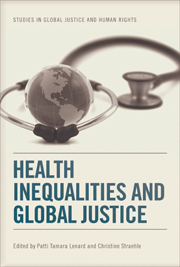Book contents
- Frontmatter
- Contents
- Acknowledgements
- Notes on the Contributors
- Introduction: Health Inequality and Global Redistributive Justice
- Part 1 A Right to Equal Health?
- Part 2 Who is Responsible for Remedying Global Health Inequality?
- Part 3 Measuring Health and Health Outcomes
- Part 4 Borders and Health
- 11 Justice and Health Inequalities in Humanitarian Crises: Structured Health Vulnerabilities and Natural Disasters
- 12 ‘Illegal’ Migrants and Access to Public Health: A Human Rights Approach
- 13 Medical Migration between the Human Right to Health and Freedom of Movement
- 14 Healthcare Migration, Vulnerability and Individual Autonomy: The Case of Malawi
- Bibliography
- Index
11 - Justice and Health Inequalities in Humanitarian Crises: Structured Health Vulnerabilities and Natural Disasters
from Part 4 - Borders and Health
Published online by Cambridge University Press: 05 August 2013
- Frontmatter
- Contents
- Acknowledgements
- Notes on the Contributors
- Introduction: Health Inequality and Global Redistributive Justice
- Part 1 A Right to Equal Health?
- Part 2 Who is Responsible for Remedying Global Health Inequality?
- Part 3 Measuring Health and Health Outcomes
- Part 4 Borders and Health
- 11 Justice and Health Inequalities in Humanitarian Crises: Structured Health Vulnerabilities and Natural Disasters
- 12 ‘Illegal’ Migrants and Access to Public Health: A Human Rights Approach
- 13 Medical Migration between the Human Right to Health and Freedom of Movement
- 14 Healthcare Migration, Vulnerability and Individual Autonomy: The Case of Malawi
- Bibliography
- Index
Summary
INTRODUCTION
The ways that individuals and communities are affected by humanitarian crises are the result of a matrix of determinants including various forms of inequality (O'Keefe 1976). These features create gradients of vulnerability – unequal susceptibility for incurring additional wrongs (Hurst 2008) – both within and between populations. Pre-existing inequalities are exacerbated in the context of catastrophes; disasters do not affect people equally and those that are already marginalised or disadvantaged (because of gender, ethnic, religious or socio-economic divides), in poor health or in precarious social situations, are likely to experience greater deprivation and harm. That vulnerability to catastrophe is determined by social, cultural and economic factors, and that catastrophes widen existing inequalities, is clear. It is less clear how these understandings should map on to programming and prioritisation for humanitarian medical assistance, and how questions of justice should be addressed by non-governmental organisations (NGOs) involved in the medical response to natural disasters in low resource settings.
In this paper, we argue that health vulnerabilities that exist in disaster-affected populations are, in part, the results of structural injustices pertaining to social and economic interactions as well as power relations between agents (both individual and collective) that can be observed at the domestic and international levels. These structural injustices are part of the context in which disaster response is carried out and contribute to how individuals and communities are affected by disaster.
- Type
- Chapter
- Information
- Health Inequalities and Global Justice , pp. 197 - 212Publisher: Edinburgh University PressPrint publication year: 2012



